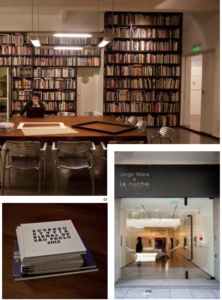Monocle, January 2014
Collectors may only just be cottoning on but art is thriving in Buenos Aires, São Paulo and Bogotá, and with the help of Art Basel Miami Beach it is reaching new markets.
Galería Jorge Mara – La Ruche
Buenos Aires
The frontage is floor-to-ceiling glass; the exhibition area understated. Located in the affluent Recoleta neighbourhood – and in its current location since 2007 – owner and curator Jorge Mara welcomes Monocle to his gallery. After a tour, we join one of the gallery’s most successful artists, Eduardo Stupía, for lunch. The topic quickly turns to Art Basel Miami Beach, which the gallery will be attending for a third time this year.
Art Basel was a godsend for the Latin American market,” says Uruguay-born Mara between mouthfuls of veal milanesa. “There are so many Brazilians buying property in Miami and they need something on their walls.”
Mara, who ran a gallery in Madrid in the 1990s, says he works mainly with established artists, nearly all of them local, and will be exhibiting the works of Sarah Grilo from the 1950s and 1960s, drawings by Carlos Arnaiz and Brazilian “Concretismo” artist Macaparana, alongside Stupía and others.
For Mara, Miami has something a little bit different – a touch of stardust. “It’s showy, so there’s a lot of excitement,” he says. “People want to buy.” Stupía, who says he always does well in Miami, attends in person and chats with collectors. This hands-on approach is surprisingly rare.
For now, the Argentinian buyers market is yet to take off – although they tend to buy more in Miami than Buenos Aires, Mara explains. Art Basel Miami Beach is nevertheless creating a new breed of buyer, especially in the US, where alongside individuals, museums and cultural institutions are taking an increasing interest in Argentinian and Latin American art.
“We have very good artists and internationally they are still affordable,” Mara says. “The big satisfaction is selling to somebody who really enjoys it. Otherwise you might as well be a banker.”
Gallery snapshot
Year opened: 2001 (founded as Galería Jorge Mara in 1984 before moving to Spain and finally back to Buenos Aires)
Number of staff: Four
International fairs: Art Basel Miami, Art Basel Hong Kong, ArtRio, arteBA, Arco Madrid
Sales: 60 per cent international, 40 per cent domestic
Curator’s word: “I work with mostly Argentinian established artists. I’m very faithful to them and try to show them at all the fairs I attend.”
In the studio with…
Eduardo Stupía at his studio in the Almagro neighbourhood, Buenos Aires
“I am not a nine to five artist. I head to the studio at around 11.00, perhaps, and sometimes at night – but when I come here, I normally work for three or four hours. It’s very rare that I work more than five hours a day but I do try to come every day.
It’s hard to have a regular routine because I do lots of other things including teaching and some writing. I had this friend who rented this other room here to store furniture and he told me about this big other room at the front. When I saw it, I immediately fell in love and had to rent it.
The building is from 1910: it’s very classical in style with wooden floors, Italian mosaic tiles and stained-glass windows. There are seven other artists who work in the same building and there’s an architecture workshop at the back. I work in silence, even though I normally listen to a lot of music. I’m used to the street noise, it doesn’t bother me; it’s like having company.
I produce around 60 new works a year. I use all kinds of materials mixed together, often very antagonistic – charcoal with oil, enamel, pencil, pastel, graphite, acrylic and watercolour – because I think when you mix materials you are also mixing a certain type of language. Each material has its own character, its own quality and its own spirit.
I am not a contemporary artist. I’m an old-fashioned artist. I am very attached to the illusion of representation. I stay in the canvas – everything happens in the canvas. I don’t have irony or cynicism and I don’t look at myself as part of the contemporary movement because sometimes the artist is almost more important than the piece – the artist is a character and has to make bold statements. I’d rather not dictate, which is why I never name my pieces of work. It has to do with my generation, my age and my type of work. I produce modern rather than contemporary art, in terms of style, concept, language and approach.”
